Death row exoneree Anthony Ray Hinton tells his compelling story to over 300 at the law school
November 23, 2016 - Tamara Williams
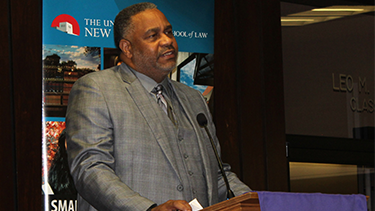
Death row exoneree Anthony Ray Hinton shared his story with over 300 people at the UNM Law School on November 10.
How did Anthony Ray Hinton spend over 30 years in a 5’x7’ cell for crimes he did not commit and emerge with his sense of humor, joyful outlook, and compassion intact?
On November 10, Hinton shared his story with over 300 people at the UNM Law School. In a talk that spanned from humorous and entertaining to heart-wrenching and compelling, he told of his wrongful conviction, survival on Alabama's death row, and decades-long journey to exoneration and freedom.
Unreliable evidence, racism, and unlawful conviction
Hinton’s story began on a hot day in July in 1985, when he was mowing the lawn. Two white police detectives arrived and arrested him, charging him with first degree kidnapping, attempted murder, and first degree armed robbery. He proclaimed his innocence and that he was working at the time of the incident, but they said it didn’t matter, because Hinton is black, the victim is white, there will be a white prosecutor, a white judge, and an all-white jury.
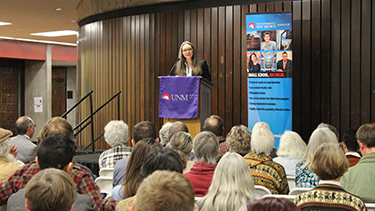
Aja Oishi, staff attorney for the New Mexico Innocence and Justice Project, introduced Hinton.
The only evidence at Hinton’s trial was a statement that ballistics tests showed crime scene bullets matched a dusty revolver found in Hinton’s mother’s closet. There were no fingerprints or eyewitness testimony.
The racism Hinton experienced initially continued throughout his trial and conviction. “Lady Justice peeks through the blindfold and sees where you’re from, your race, your background, and before you even enter the courtroom, it’s already determined whether you’re guilty or not.”
Three years of silence, then humor and compassion
For the first three years he was imprisoned, Hinton was filled with hate and rage at the injustice of the legal system. He talked to no one. He prayed to God to free him from his hatred, and gradually his faith and belief in God and inspiration from his mother softened him. He says his mother taught him that, “I am responsible for how I treat others, not how others treat me.”
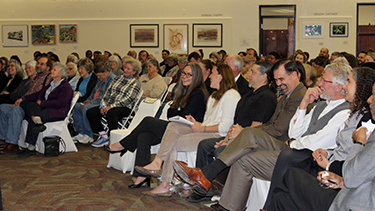
Hinton has maintained his sense of humor and the audience laughed several times during his presentation.
He enjoys making people laugh, and the audience laughed several times as he described how he used his imagination in prison. Hinton fantasized about being married to Halle Berry; how she didn’t spend any money, was loyal, and said, “yes, dear!” frequently. Then he saw “Speed” and fell in love with Sandra Bullock. Berry graciously gave him a divorce, never asked for alimony and was glad he and Bullock were so happy.
The revolver, a long appeals process, and freedom at last
Hinton spent years arguing that the revolver didn't match the evidence at the scenes. He described his appeals process, and the help he received from Bryan Stevenson of the Equal Justice Initiative (EJI), which was the key to his release.
After years of petitioning to have the revolver re-analyzed, three independent experts concluded that the bullets could not have been fired from that revolver, nor could they have been fired from the same gun. The bullets said to have been from the rusty gun found in Hinton’s mother’s closet did not match the bullets.
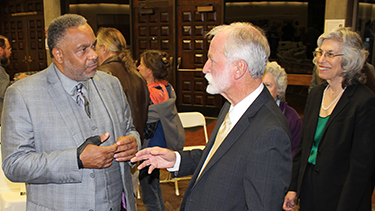
Hinton spoke with New Mexico Supreme Court Justice Charles Daniels after the event.
Even though the ballistics tests showed he was innocent, Hinton remained in jail. EJI continued to wage the fight for Hinton’s release and fifteen years later, the case went to the United States Supreme Court, which ruled unanimously for Hinton to receive a new trial.
Free at last, he promised his fellow death row inmates to do his best to help. He never received an apology from the State of Alabama for being wrongfully convicted. He claims that judges worry about being re-elected and thus tend not to rule to release death row inmates. Hinton asked, “How many people do we need to be exonerated to get rid of the death penalty?”
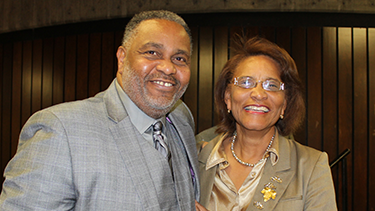
Hinton with Pamelya Herndon of the Southwest Women's Law Center.
The role of the NM Innocence & Justice Project
After a lively question and answer period, Gordon Rahn, Director of the New Mexico Innocence and Justice Project, gave an overview of NMIJP, the only organization in New Mexico that investigates claims of factual innocence. The project also teaches law students how a criminal investigation is conducted. Rahn says that students learn to do in-depth investigations, which are key to righting wrongful convictions and creating better lawyers. During the process of reviewing the cases, students are learning not only from NMIJP staff but from other New Mexico lawyers, prosecutors, judges, and appellate judges.
However, the grant supporting NMIJP doesn’t cover all the costs. To make a gift or pledge or to learn more about the project, go to: http://lawschool.unm.edu/ijp/index.php
Videos for the NM IJP Speaker Series
Hinton’s presentation is the second in the New Mexico Innocence and Justice Project Fall Speaker Series, made possible through the generous support of the Lannan Foundation.
Watch Hinton’s presentation here: https://www.youtube.com/watch?v=0MTv2w7x4yA&feature=youtu.be
Crime victim Jennifer Thompson gave the first presentation in the IJP Fall Speaker Series. Watch Thompson’s presentation here: https://www.youtube.com/watch?v=H0gEtsyjXVw

Hinton met with a few of the members of the IJP Board of Directors and IJP Director Gordon Rahn (left).
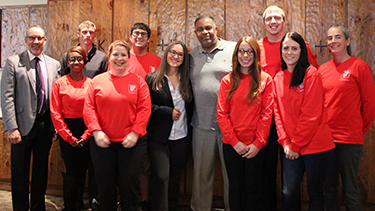
Before his presentation, Hinton met with students in the IJP project.
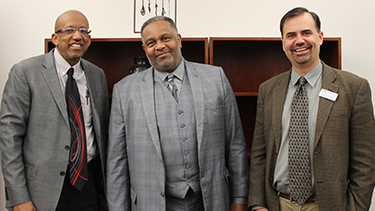
Hinton also met with UNM Law School Dean Alfred Mathewson (left) and Dean Sergio Pareja (right).
